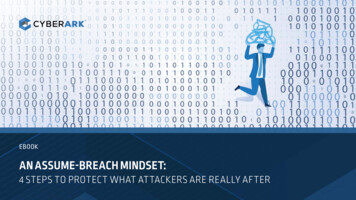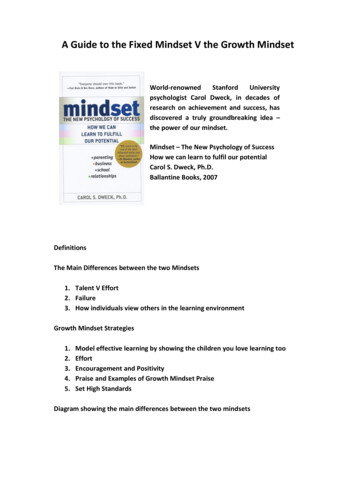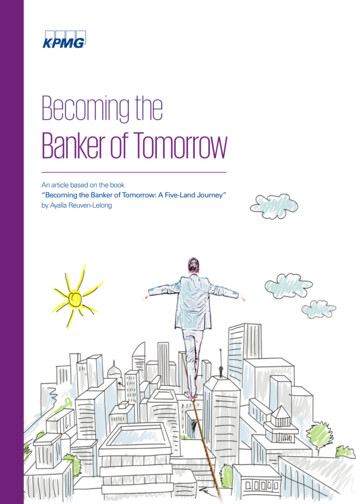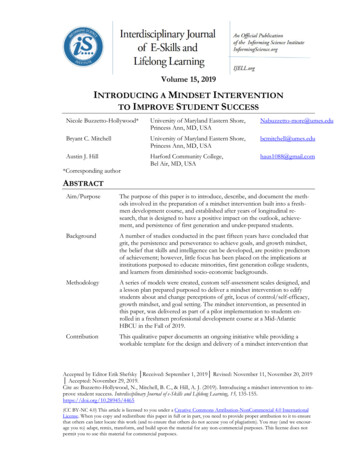
Transcription
EBOOKAN ASSUME-BREACH MINDSET:4 STEPS TO PROTECT WHAT ATTACKERS ARE REALLY AFTER1www.cyberark.com
THINK LIKE AN ATTACKERTraditional perimeter-based IT security models conceived to control access totrusted enterprise networks aren’t well suited for today’s world of cloud servicesand mobile users. Savvy attackers can breach enterprise networks and fly under theradar for weeks or longer. The 2020 SolarWinds supply chain attack went undetectedfor nine months, impacting over 18,000 organizations.Threat actors are always finding new and innovative ways to penetrate networks, stealdata, and disrupt business. It’s not a question of if a breach will happen, but when.Cyberattacks can damage your company’s reputation and result in costly regulatory fines,lawsuits, and revenue loss. The average total cost of a data breach exceeds 3.8M.*It’s time to adopt an “assume-breach” mindset to detect and isolate adversaries beforethey traverse your network and inflict serious damage. An assume-breach mindset meansthinking like an attacker.If, like us, you spend a lot of time helping organizationsprevent and respond to attacks and breaches, you getto know a lot about how attackers think. So in this guide,we’re using what we’ve learned to help you protect yourorganization against the most common attack pathsattempting to compromise your most critical assets.Listen toShay NahariDirector Red Team:ContentsAdopting an assume-breach mindset. 3Zeroing in on Privileged Access Management. 4Know where to start: privileged accountsare not all equal. 51. Protect against tier 0 compromise. 72. Secure all privileged infrastructure accounts. 83. Limit lateral movement from endpoints. 94. Widen the program and actively maintain it. 10Assume breach Think like anattacker* IBM Security, Cost of a Data Breach Report, ost-data-breach-report/#/2www.cyberark.com
ADOPTING AN ASSUME-BREACH MINDSETBy adopting an assume-breach mentality and thinking like an attacker, you canefficiently identify suspicious activity, restrict lateral movement, and containthreats. An assume-breach mindset requires a defense-in-depth approach tosecurity. By implementing multiple layers of defense, you can improve yoursecurity posture and mitigate risk.Now is the time to take a fresh look at your security portfolio. Augment existingcontrols like endpoint detection and response tools, next-generation anti-virusprotection solutions, and application/OS patching best practices with cloud detectionand response tools, and zero-trust, identity-based security solutions. 79% ofenterprises have experienced an identity-related breach within the past two years*and 80% of breaches tied to hacking involve the use of lost or stolen credentials.**Identity-based security controls are critical for detecting and thwarting advancedattacks. Bad actors often exploit privileged identities in particular – to steal data orwreak havoc. In fact, nearly 100% of advanced attacks involve compromised privilegecredentials.Privileged Access Management (PAM) should be considered at the core of a defensein-depth approach that is geared to protect critical infrastructure, safeguardconfidential data, and making the most of your technology investments.* Identity Defined Security Alliance (IDSA), The State of Identity: How Security Teams are Addressing Risk, December, s-are-addressing-risk/** Verizon, Data Breach Investigations Report, 2020, orts/dbir/3www.cyberark.com
ZEROING IN ON PRIVILEGED ACCESSMANAGEMENTWould it surprise you to know that, as a general rule, your organization will havethree to five times more privileged accounts than the number of people youemploy? They comprise: System access accounts that come by default with servers, workstations andapplications (for example, Windows administrator accounts, root accounts in UNIX,and Oracle SYS and SYSTEM accounts), and give ‘all-access’ privileges to the relevantsystem. Technical access administrative accounts, created by your organization so yourpeople can do their jobs (for example, accounts for IT operations, support anddevelopment). This is typically your largest set of privileged accounts, but attackersare not equally interested in all of them. Their primary targets are the most powerfulones, especially domain administrator accounts. Application access accounts, created so that machines can access systems and dataon other machines, usually to support process automation. These are non-interactive,machine-to-machine accounts.Privileged accountstypically outnumberemployees by 3-5xYou can’t flip a switch to protect all of these, all at once — you need to prioritize thework required, so as to achieve the greatest reduction in risk as quickly and efficientlyas possible. This is where it pays to know how attackers think and act.4www.cyberark.com
KNOW WHERE TO START:NOT ALL PRIVILEGED ACCOUNTS ARE CREATED EQUALThe jackpot for an attacker is your most powerful technical and system accounts: the administrator accounts that provideaccess to critical assets, such as Active Directory domain controllers and other high-level AD domains.LATERAL MOVEMENTLATERAL ERTIER 2TIER 1TIER 0To get to these, attackers target accounts accessible from end-userdevices (tier 2, where the compromise initially starts) and work their wayfrom there towards more powerful accounts which themselves usuallygive access to sensitive data (tier 1 system and technical accounts).5This lateral movement may leverage system accounts, because they’reoften set to the same password across similar devices (for example, samelocal administrator password on endpoints). Your most powerful technicalaccounts come into play as the attacker gets deeper into your network,aiming for the systems that give control over all other systems (tier 0).www.cyberark.com
The most efficient and effective way to protect yourselffrom lateral movement is to work from the inside out:1. P rotect against tier 0 compromise (irreversible network takeover attacks)2. Secure all privileged infrastructure accounts3. Limit lateral movement from endpoints4. W iden the program to secure lower-priority technical and applicationaccess accounts6www.cyberark.com
1. PROTECT AGAINST TIER 0 COMPROMISEThink like an attacker“If I can compromise the Kerberos system that authenticates Active Directoryaccounts, I can do anything I want and nobody will know. They’ll pretty much have torebuild from scratch to get rid of me.”How they do itThe most common (though not the only) security lapses we find at tier 0 level are: Allowing access from tier 1 or 2 systems to tier 0 systemsUse of single factor authentication for domain administrator accountsFailure to change domain administrator account passwords frequently enoughThese lapses give attackers openings to exploit, such as capturing residualpassword hashes from long-lasting domain administrator passwords.Listen toDavid HigginsTechnical DirectorAssume Breach Where to Start7How to reduce the riskAs a matter of priority you’llwant to block access to tier 0assets from accounts managingtier 1 and 2 assets. If, forexample, one employee needsto manage a mix of tier 1 andtier 0 assets, they should doso from different privilegedaccounts, each of which hasaccess only to its own tier.In parallel, choose a privilegedaccess management (PAM)solution, preferably onewith integrated multi-factorauthentication support. Thiswill enable you to generate aunique one-time password forevery use of a tier 0 account,eliminating much of the danger.www.cyberark.com
2. SECURE ALL PRIVILEGED INFRASTRUCTUREACCOUNTSThink like an attacker“If I get access to the right default infrastructure account, I can take ownership of an entire technologystack — and all the sensitive data it holds. Even better, I’ll probably be able to use the same credentials toaccess other, similar infrastructure including CI/CD systems!”How they do itAs with tier 0 accounts, the main exploitable issue here is with passwords for default system accounts thatare only infrequently, or never, changed. The issue is exacerbated by the sheer number of these privilegedaccounts across your Windows, Unix/Linux, Cisco, SQL, Oracle, cloud and other systems. Even worse,because these are accounts shared among multiple users and teams, they are often set to memorable,weak passwords.How to reduce the riskDon’t rely on ad-hoc password management: it’s too easy for somethingto slip through. Make sure that the scope of your PAM implementationgoes beyond tier 0 accounts to bring all default infrastructure systemaccounts under proper management.8Listen toJean-Christophe VituVP Solution EngineersEMEA:Assume Breach Securing YourInfrastructure Accountswww.cyberark.com
3. LIMIT LATERAL MOVEMENTFROM ENDPOINTSThink like an attacker“There’s a good chance that senior executives or members of the IT team have localadministrative rights to their workstations or that default workstation administrativeaccounts haven’t been touched and are vulnerable to takeover. I’m going to keep at it withphishing emails until I hook someone, then go from there.”How they do itAs long as you have employees with local administrative rights to the machines they areusing, attackers will continue to target and exploit them. Even the most IT-savvy usercan fall prey to some of today’s more sophisticated attack vectors, and many are notparticularly IT-savvy.How to reduce the riskIt’s important to educate all your users about security and howto avoid falling prey to attackers. But since there’s no way toprevent fallible humans from making mistakes (and mistakesbecomes inevitable with enough employees or enough time),you should also, by default, completely remove all endpointusers from the local admin groups on their workstations.* CyberArk Labs, Analyzing Ransomware and Potential Mitigation Strategies, trategies-29Listen toBart BruijnesteijnDirector PresalesNorth Europe:Assume Breach Limit Lateral MovementThe removal of local administrator rightscombined with application control is100%effective in preventing ransomware fromencrypting files*.www.cyberark.com
4. WIDEN THE PROGRAM AND ACTIVELYMAINTAIN ITWith the first three steps you’ll have done the most important work to protect yourcritical assets, but it won’t mean that attackers will stop trying. To further boost yourdefenses you’ll ultimately want to address the many privileged accounts that steps 1,2 and 3 will leave untouched, namely all of your tier 1 and 2 technical access accountsand application access accounts, including: Developer and DevOps accounts Application access accounts used for any form of system scanning, ticketing,automated login, robotic process automation, or cloud orchestrationBusiness accounts, often shared among multiple users, with privileged access tofinancial, HR, customer and other systems with sensitive dataRemember, too, that nothing about privileged accessmanagement stands still. Infrastructure, applicationsand employees all come and go, move around, andchange in other ways. It takes a structured andcontinually maintained approach to stay on top of itall, and this should include being able to measure yourprogress, and regular validation of the effectiveness ofyour PAM controls against simulated attacks.10Listen toChristian GötzDirector PresalesDACH:Assume Breach Widen the Programwww.cyberark.com
FIND OUT MOREVisit cyberark.com to learn more about how CyberArk can help you adopt adefense-in-depth approach to security with Privileged Access Managementat the core.About CyberArkCyberArk (NASDAQ: CYBR) is the global leader in Identity Security. Centered on privileged accessmanagement, CyberArk provides the most comprehensive security solutions for any identity - human ormachine - across business applications, distributed workforces, hybrid cloud workloads, and throughoutDevOps pipelines. The world’s leading organizations trust Cyberark to help secure their most critical assets.To learn more about CyberArk, visit www.cyberark.com.THIS PUBLICATION IS FOR INFORMATIONAL PURPOSES ONLY AND IS PROVIDED “AS IS” WITH NO WARRANTIES WHATSOEVER WHETHER EXPRESSED OR IMPLIED, INCLUDING WARRANTY OF MERCHANTABILITY, FITNESS FOR ANY PARTICULARPURPOSE, NON-INFRINGEMENT OR OTHERWISE. IN NO EVENT SHALL CYBERARK BE LIABLE FOR ANY DAMAGES WHATSOEVER, AND IN PARTICULAR CYBERARK SHALL NOT BE LIABLE FOR DIRECT, SPECIAL, INDIRECT, CONSEQUENTIAL, ORINCIDENTAL DAMAGES, OR DAMAGES FOR LOST PROFITS, LOSS OF REVENUE OR LOSS OF USE, COST OF REPLACEMENT GOODS, LOSS OR DAMAGE TO DATA ARISING FROM USE OF OR IN RELIANCE ON THIS PUBLICATION, EVEN IF CYBERARKHAS BEEN ADVISED OF THE POSSIBILITY OF SUCH DAMAGES. 02.21. Doc. 21230211www.cyberark.com
Identity-based security controls are critical for detecting and thwarting advanced attacks. Bad actors often exploit privileged identities in particular - to steal data or wreak havoc. In fact, nearly 100% of advanced attacks involve compromised privilege credentials. Privileged Access Management (PAM) should be considered at the core of a .










